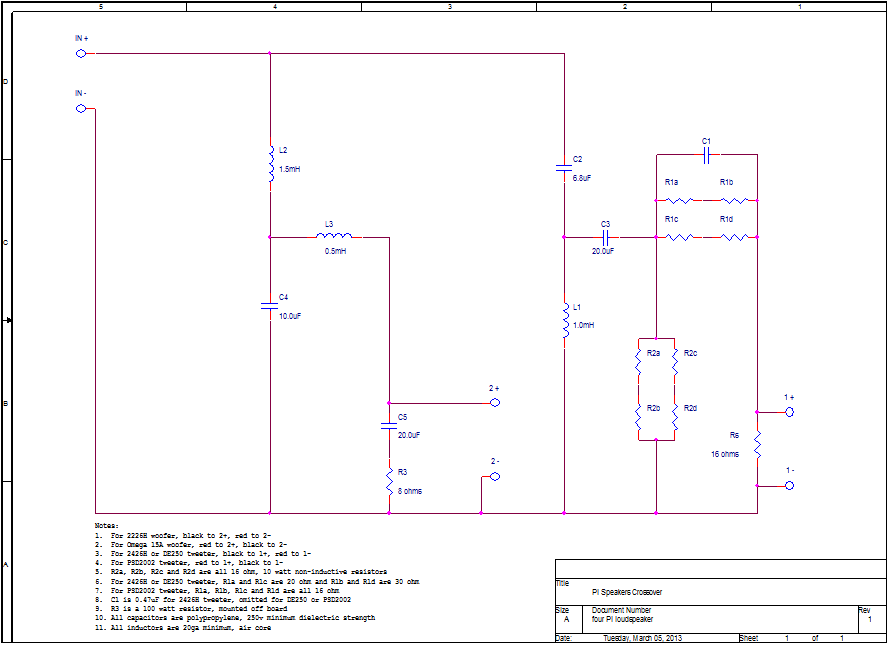| Re: 4pi Crossover Questions [message #75359 is a reply to message #75358] |
Sat, 26 January 2013 21:53   |
 |
 Wayne Parham
Wayne Parham
Messages: 18990
Registered: January 2001
|
Illuminati (33rd Degree) |
|
|
Answers follow:
| klosters wrote on Sat, 26 January 2013 18:08 | I might need to request new plans as the ones I have are over a year old. The crossover schematic is revision 1, dated 1/30/08. I have the H290C horns and have read that with these, capacitor C1 is not needed. I just want to confirm this and make sure there are no other changes that I am not aware of.
|
That's right, C1 is not needed with the H290C/DE250. Other than that, it's the same crossover as before. The most current crossover is here:
 four π crossover schematic
four π crossover schematic
| klosters wrote on Sat, 26 January 2013 18:08 | R3 resistor
There doesn't seem to be a lot of choices out there and I did not find any advertised for audio or from the typical audio supplier sources. Am I missing something?
Mouser has a several options that meet specs. One has lower inductance than the others but costs quite a bit more. Is lower inductance better at this location or does it matter?
|
A little bit of parasitic inductance doesn't matter much in this location. The main thing is that it be capable of handling power well. So don't derate this part unless you'll only use low power amps. Even then, the extra power handling helps keep things cool, which is always a good thing.
| klosters wrote on Sat, 26 January 2013 18:08 | R2a-d resistors
I have decided to go with Mills resistors but they only have 15 ohm values, not the 16 ohm value called for in the schematic. I found a thread where Wayne said that he uses 15 ohm resistors when using Mills. Knowing this, my questions may seem even more absurd... but I gotta ask. By my calculations if I substitute one of the four 15 ohm resistors with a 20 ohm resistor the total value will be 16.1 ohms. This is very close to the value when using 16 ohm resistors and an improvement over using just 15 ohm resistors. Is there any benefit in mismatching the Mills to get closer to the spec? Are there any disadvantages created by mismatching the resistors in the series / parallel circuit?
|
We use 15Ω Mills parts in those locations. You can substitute one with a 20Ω part if you want. There will be no benefit, but there will also be no harm. Either way is within tolerance.
| klosters wrote on Sat, 26 January 2013 18:08 | Inductors
I have decided to go with the larger wire inductors. There are options available in 14 AWG and 15 AWG. It seems like these are so close it wouldn't make any difference. There are options from Jantzen with 15 AWG and Solen with 14 AWG, but the price is basically the same. Options from Erse and Meniscus are 14 AWG but cost quite a bit more. Is bigger wire always better? Should I concern my self with the brand?
|
Where inductors are concerned, bigger is almost always better. There is a point of diminishing returns at 14 guage, but even though the improvements start becoming less and less, it is still good to reduce DCR, especially if you might run an amp with higher output impedance. Don't need to add to it. So there's no harm going larger, it's always a good thing.
Jantzen, Solen and Erse are all good brands that I think you'll be happy with. I use each of those brands and keep them in stock. The main thing is that they all be air core coils.
|
|
|
|







